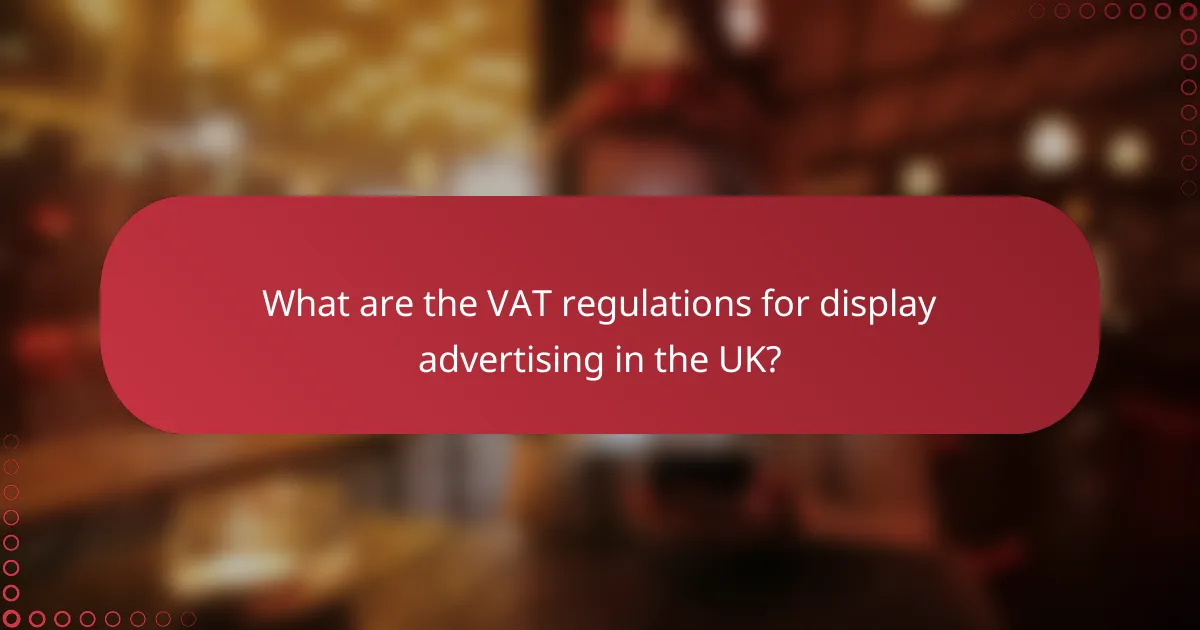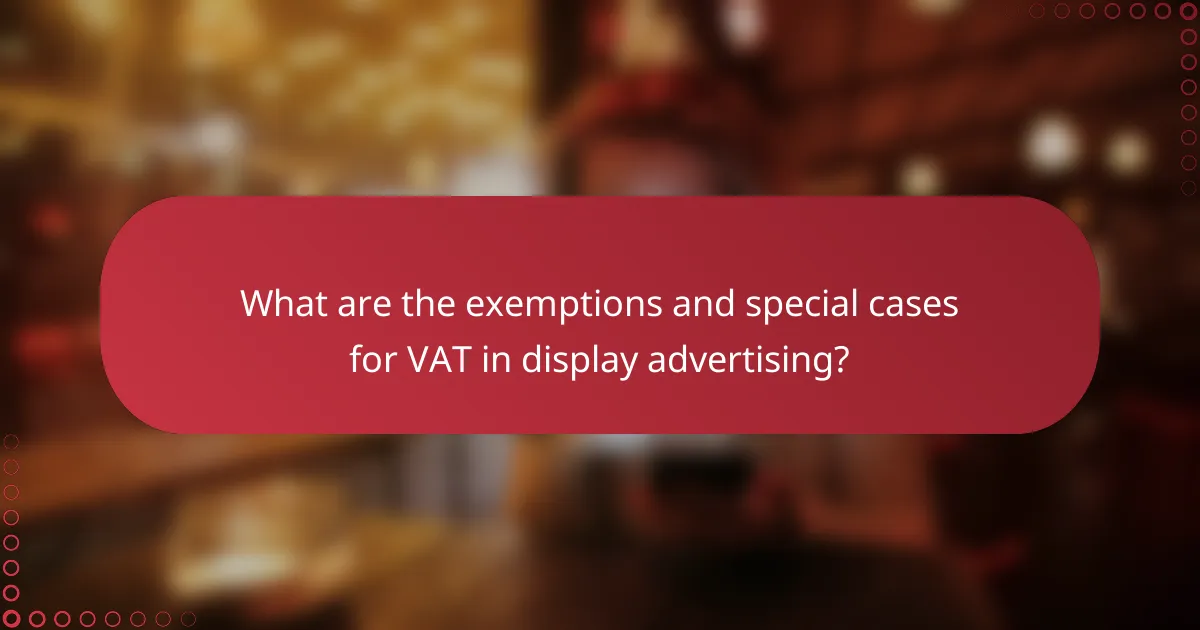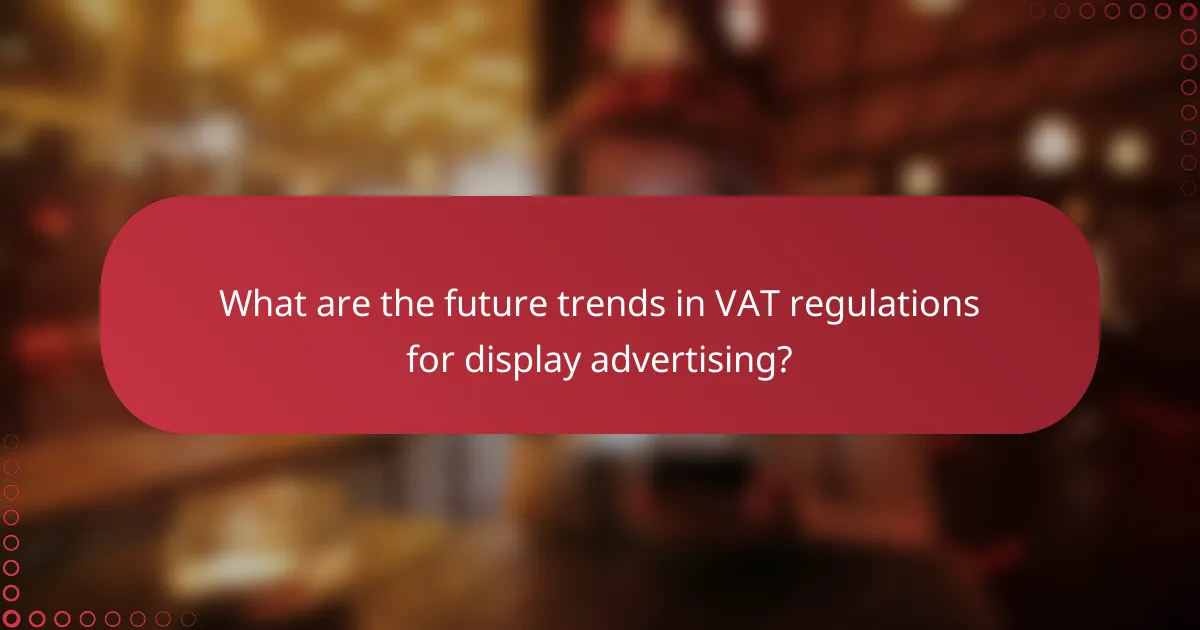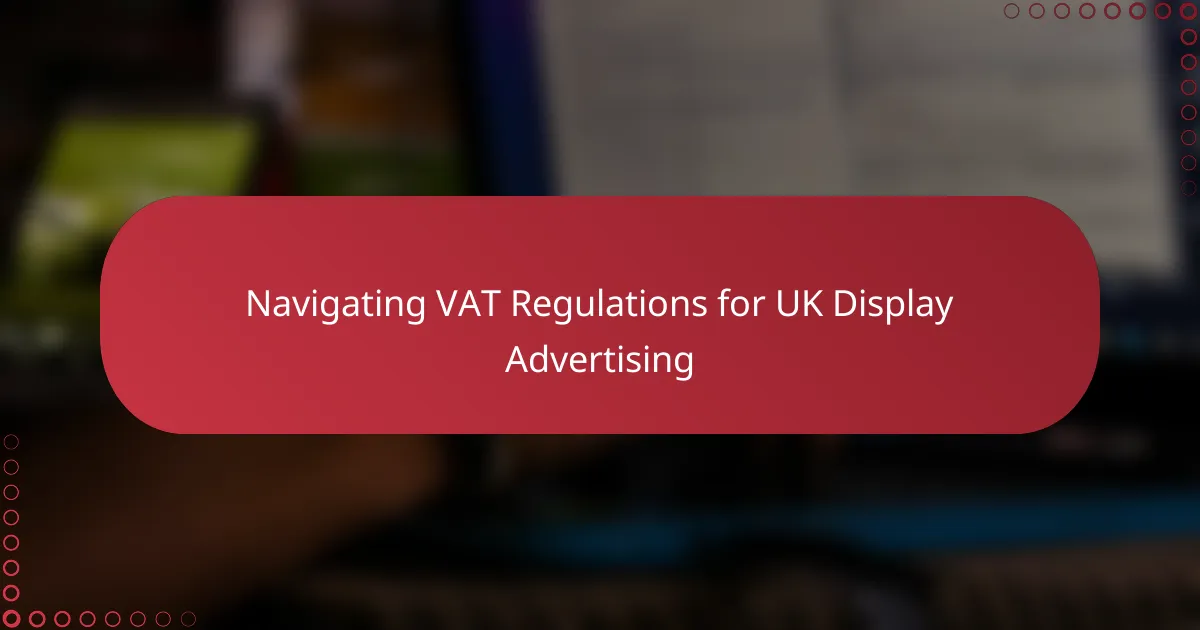Navigating VAT regulations for display advertising in the UK is essential for businesses to ensure compliance and effective financial planning. Advertising services are subject to VAT at the standard rate, which can significantly impact overall costs and budgeting strategies. Understanding the registration process with HM Revenue and Customs (HMRC) is crucial, especially once a business’s taxable turnover exceeds the VAT threshold.

What are the VAT regulations for display advertising in the UK?
The VAT regulations for display advertising in the UK require businesses to charge VAT on advertising services, typically at the standard rate. Understanding these regulations is crucial for compliance and financial planning.
Standard VAT rate applies
The standard VAT rate in the UK is currently set at 20%. This rate applies to most goods and services, including display advertising. Businesses must ensure they include this rate when invoicing clients for advertising services.
For example, if a display advertising campaign costs £1,000, the total amount billed to the client would be £1,200, including VAT. It’s important to keep accurate records of all transactions to facilitate VAT reporting and payments.
Digital services VAT rules
Digital services, including online display advertising, are subject to specific VAT rules. If the service is provided to a business customer located outside the UK, the reverse charge mechanism may apply, meaning the customer accounts for the VAT instead.
For businesses targeting consumers in the EU, they must comply with the VAT MOSS (Mini One Stop Shop) scheme, which simplifies VAT reporting for cross-border digital services. This means businesses can report and pay VAT in one EU country rather than in each member state where services are provided.

How to register for VAT in the UK?
To register for VAT in the UK, businesses must apply through HM Revenue and Customs (HMRC) once their taxable turnover exceeds the VAT threshold. Registration can be completed online, and it is essential for compliance with tax regulations.
Online registration process
The online registration process for VAT in the UK is straightforward. Businesses can register through the HMRC website by creating an account and filling out the necessary forms. It typically takes about 2-4 weeks to receive a VAT registration number after submission.
During the online application, you will need to provide details about your business, including its structure and estimated turnover. Ensure that all information is accurate to avoid delays in processing.
Required documentation
It is advisable to have these documents ready before starting the registration process to streamline your application. Missing or incorrect documentation can lead to delays or complications in your VAT registration.

What are the implications of VAT for display advertising costs?
VAT significantly affects display advertising costs in the UK by adding a percentage to the overall price. Businesses must account for VAT when budgeting for advertising, as it impacts both the total expenditure and pricing strategies.
Impact on pricing strategies
When incorporating VAT into pricing strategies, businesses must ensure that their pricing reflects the additional tax burden. This may involve adjusting the base price of advertising services to maintain profit margins while remaining competitive. For example, if a display ad costs £100, the total cost with VAT at 20% would be £120.
Companies often need to communicate these changes transparently to clients, as clients may expect to see clear breakdowns of costs. Offering pricing options that include VAT can help avoid confusion and foster trust.
Effect on profit margins
The inclusion of VAT can compress profit margins for display advertising services. If businesses do not adjust their pricing accordingly, they risk losing profitability. For instance, if a company absorbs the VAT instead of passing it on to clients, their margins could shrink significantly.
To mitigate this, businesses should regularly review their pricing structures and consider the overall market conditions. Monitoring competitor pricing and understanding client expectations can help in making informed decisions about how to handle VAT in pricing strategies.

How to manage VAT compliance for display advertising?
Managing VAT compliance for display advertising in the UK involves understanding the applicable VAT rates, ensuring accurate reporting, and maintaining proper records. Businesses must adhere to HMRC regulations to avoid penalties and ensure smooth operations.
Regular VAT reporting
Regular VAT reporting is essential for businesses engaged in display advertising. Companies must submit VAT returns quarterly or annually, depending on their turnover. Each return should detail sales, purchases, and the VAT collected or paid.
To stay compliant, businesses should track all advertising expenses and income accurately. This includes invoices from advertising platforms and any VAT charged on those services. Missing or incorrect information can lead to fines or audits.
Using accounting software like Xero
Using accounting software such as Xero can simplify VAT compliance for display advertising. Xero automates the tracking of income and expenses, generating VAT returns with minimal manual input. This reduces the risk of errors and saves time.
Additionally, Xero allows businesses to categorize transactions easily, ensuring that all relevant VAT data is captured. Regularly reconciling accounts within the software can help identify discrepancies early, preventing issues during VAT reporting.

What are the exemptions and special cases for VAT in display advertising?
In the UK, display advertising can be subject to various VAT exemptions and special cases, which can significantly impact the tax obligations of businesses. Understanding these nuances is essential for compliance and financial planning.
Zero-rated supplies
Zero-rated supplies refer to goods and services that are taxable at a rate of 0%. In the context of display advertising, certain advertising services may qualify for this status, allowing businesses to charge VAT at 0% while still being able to reclaim input VAT on related costs. Common examples include advertising in newspapers or magazines that are published at least once a month.
To ensure eligibility for zero-rating, businesses must keep accurate records and confirm that their advertising services meet the necessary criteria set by HM Revenue and Customs (HMRC). This can include verifying the publication frequency and the nature of the advertising medium.
Exemptions for certain services
Some advertising services may be exempt from VAT altogether, meaning that businesses cannot charge VAT on these services and cannot reclaim input VAT. Exemptions typically apply to specific types of advertising, such as those related to certain educational or charitable activities. For instance, advertising for non-profit organizations might fall under this category.
It is crucial for businesses to identify whether their advertising services fall into these exempt categories to avoid unexpected tax liabilities. Consulting with a tax professional can help clarify which services are exempt and ensure compliance with current regulations.

How does VAT differ across Europe for display advertising?
VAT regulations for display advertising vary significantly across Europe, impacting how businesses charge and reclaim VAT. Each country has its own rates and rules, which can affect pricing strategies and compliance requirements for advertisers.
Comparative VAT rates in Germany
In Germany, the standard VAT rate is 19%, with a reduced rate of 7% applicable to certain goods and services. Display advertising typically falls under the standard rate, meaning businesses must charge 19% VAT on their services. It’s essential for advertisers to factor this rate into their pricing and invoicing practices.
When dealing with cross-border advertising, businesses should also consider the implications of the EU’s VAT rules, which may affect how VAT is applied based on the location of the service recipient. Proper documentation and compliance with local regulations are crucial to avoid penalties.
VAT regulations in France
France has a standard VAT rate of 20%, which applies to most goods and services, including display advertising. Businesses must ensure they are registered for VAT if their taxable turnover exceeds a certain threshold, which is currently set at €85,800 for services.
In addition to the standard rate, France offers reduced rates for specific sectors, but these do not typically apply to advertising services. Companies should maintain accurate records of their VAT transactions to facilitate reclaiming VAT on business expenses and ensure compliance with French tax authorities.

What are the future trends in VAT regulations for display advertising?
Future trends in VAT regulations for display advertising in the UK are likely to focus on increased compliance requirements and digital service taxation. As the digital advertising landscape evolves, regulators may implement more stringent rules to ensure fair taxation and transparency.
Increased Compliance Requirements
As VAT regulations adapt to the digital economy, businesses engaged in display advertising will face heightened compliance obligations. This includes maintaining accurate records of transactions and ensuring that VAT is correctly applied to services provided. Companies may need to invest in robust accounting systems to manage these requirements effectively.
For instance, businesses might be required to submit more detailed VAT returns, including breakdowns of advertising services rendered and corresponding VAT amounts. This shift could lead to increased administrative costs and necessitate ongoing training for staff to stay updated on regulatory changes.
Digital Service Taxation
The UK government has shown interest in taxing digital services, which could impact display advertising. This taxation approach aims to ensure that companies generating significant revenue from UK users contribute fairly to the economy. As a result, businesses may need to adjust their pricing strategies to accommodate potential new taxes.
For example, if a digital service tax is introduced, companies might consider passing on some of the costs to clients or adjusting their service offerings. Staying informed about proposed legislation and engaging with industry groups can help businesses prepare for these changes.
Focus on Transparency and Fairness
Future VAT regulations are expected to emphasize transparency and fairness in the digital advertising sector. This could involve clearer guidelines on how VAT applies to various advertising formats and platforms. Businesses will need to be proactive in understanding these guidelines to avoid penalties.
Engaging with tax advisors and participating in industry forums can provide valuable insights into upcoming regulatory changes. Companies should also consider implementing transparent pricing models that clearly outline VAT charges to clients, fostering trust and compliance.



